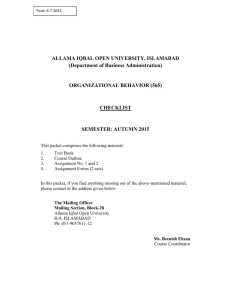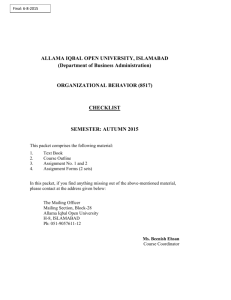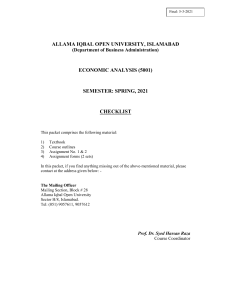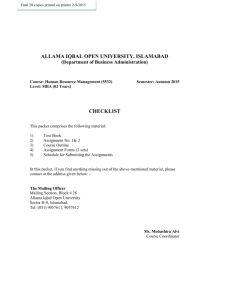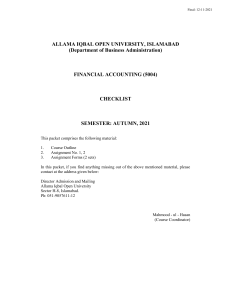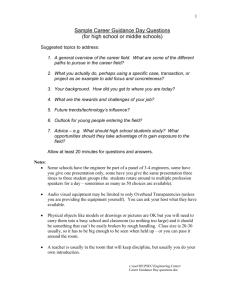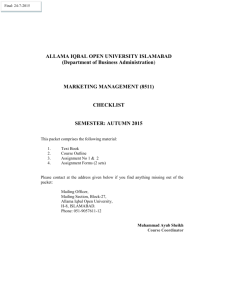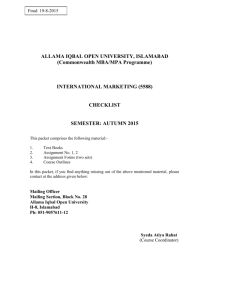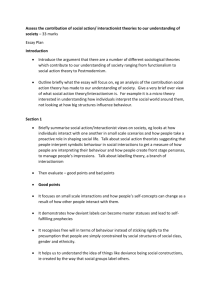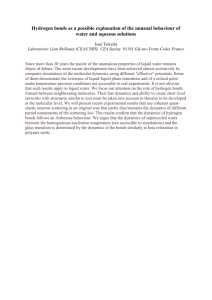- Allama Iqbal Open University
advertisement
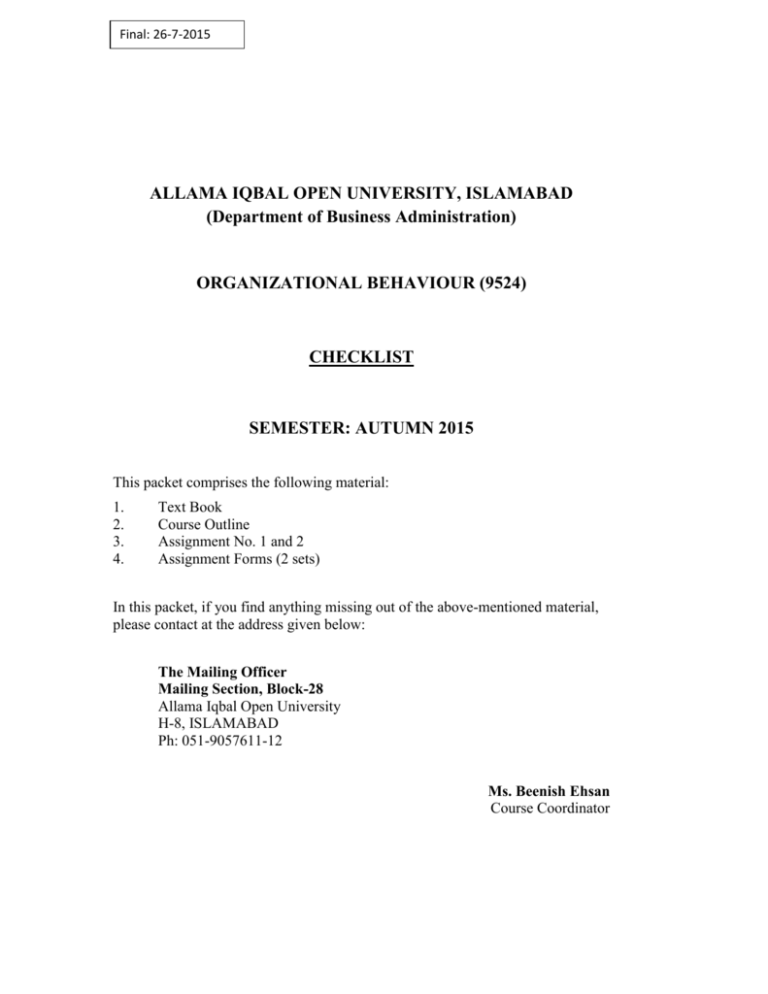
Final: 26-7-2015 ALLAMA IQBAL OPEN UNIVERSITY, ISLAMABAD (Department of Business Administration) ORGANIZATIONAL BEHAVIOUR (9524) CHECKLIST SEMESTER: AUTUMN 2015 This packet comprises the following material: 1. 2. 3. 4. Text Book Course Outline Assignment No. 1 and 2 Assignment Forms (2 sets) In this packet, if you find anything missing out of the above-mentioned material, please contact at the address given below: The Mailing Officer Mailing Section, Block-28 Allama Iqbal Open University H-8, ISLAMABAD Ph: 051-9057611-12 Ms. Beenish Ehsan Course Coordinator ALLAMA IQBAL OPEN UNIVERSITY, ISLAMABAD (Department of Business Administration) WARNING 1. 2. PLAGIARISM OR HIRING OF GHOST WRITER(S) FOR SOLVING THE ASSIGNMENT(S) WILL DEBAR THE STUDENT FROM AWARD OF DEGREE/CERTIFICATE, IF FOUND AT ANY STAGE. SUBMITTING ASSIGNMENT(S) BORROWED OR STOLEN FROM OTHER(S) AS ONE’S OWN WILL BE PENALIZED AS DEFINED IN “AIOU PLAGIARISM POLICY”. Course: Organizational Behaviour (9524) Level: MBA Semester: Autumn 2015 Total Marks: 100 Pass Marks: 50 GUIDELINES FOR ASSIGNMENT No. 1 & 2: You should look upon the assignments as a test of knowledge, management skills, and communication skills. When you write an assignment answer, you are indicating your knowledge to the teacher: Your level of understanding of the subject; How clearly you think? How well you can reflect on your knowledge & experience? How well you can use your knowledge in solving problems, explaining situations, and describing organizations and management? How professional you are, and how much care and attention you give to what you do? To answer a question effectively, address the question directly, bring important related issues into the discussion, refer to sources, and indicate how principles from the course materials apply. You must also be able to identify important problems and implications arising from the answer. For citing references, writing bibliographies, and formatting the assignment, APA format should be followed. ASSIGNMENT No. 1 (Units: 1–5) Q. 1 Define organizational behaviour. Also discuss different challenges faced by management. (20) Q. 2 Discuss the following in relation to the organizations working in Pakistan. (a) Learning Organizations (b) Motivation (20) Q. 3 Explain process and contemporary theories of motivation. (20) Q. 4 Describe group dynamics and teams. (20) Q. 5 Define occupational stress and explain its effects. (20) 2 ASSIGNMENT No. 2 (Units: 1–9) Total Marks: 100 Pass Marks: 50 This assignment is a research-oriented activity. You are required to obtain information from a business/commercial organization and prepare a report of about 1000 words on the topic allotted to you to be submitted to your teacher for evaluation. You are required to select one of the following topics according to the last digit of your roll number. For example, if your roll number is P-3427180 then you will select topic # 0 (the last digit): Topics 0) Learning organization 1) Job satisfaction 2) Challenges faced by management 3) Types of conflicts 4) Stress management 5) Total quality management 6) Leadership 7) Decision making 8) Communication technology 9) Motivating performance The report should follow the following format: 1) Title page 2) Acknowledgements 3) An abstract (one page summary of the paper) 4) Table of contents 5) Introduction to the topic (brief history & significance of topic assigned) 6) Practical study of the organization (with respect to the topic) 7) Data collection methods 8) SWOT analysis (strengths, weaknesses, opportunities & threats) relevant to the topic assigned 9) Conclusion (one page brief covering important aspects of your report) 10) Recommendations (specific recommendations relevant to topic assigned) 11) References (as per APA format) 12) Annexes (if any) GUIDELINES FOR ASSIGNMENT # 2: 1.5 line spacing Use headers and subheads throughout all sections Organization of ideas Writing skills (spelling, grammar, punctuation) Professionalism (readability and general appearance) Do more than repeat the text Express a point of view and defend it. 3 WORKSHOPS The workshop presentations provide you opportunity to express your communication skills, knowledge & understanding of concepts learned during practical study assigned in assignment # 2. You should use transparencies and any other material for effective presentation. The transparencies are not the presentation, but only a tool; the presentation is the combination of the transparencies and your speech. Workshop presentation transparencies should only be in typed format. The transparencies should follow the following format: 1) Title page 2) An abstract (one page summary of the paper) 3) Introduction to the topic (brief history & significance of topic assigned) 4) Practical study of the organization (with respect to the topic) 5) Data collection methods 6) SWOT analysis (strengths, weaknesses, opportunities & threats) relevant to the topic assigned 7) Conclusion (one page brief covering important aspects of your report) 8) Recommendations (specific recommendations relevant to topic assigned) GUIDELINES FOR WORKSHOP PRESENTATION: Make eye contact and react to the audience. Don't read from the transparencies or from report, and don't look too much at the transparencies (occasional glances are acceptable to help in recalling the topic to cover). A 15-minute presentation can be practiced several times in advance, so do that until you are confident enough. Some people also use a mirror when rehearsing as a substitute for an audience. WEIGHTAGE OF THEORY & PRACTICAL ASPECTS IN ASSIGNMENT # 2 & WORKSHOP PRESENTATIONS Assignment # 2 & workshop presentations are evaluated on the basis of theory & its applicability. The weightage of each aspect would be: Theory: 60% Applicability (practical study of the organization): 40% PREPARE ASSIGNMENTS AS PER THESE GUIDELINES AND IT MAY BE RE-EVALUATED BY THE QUALITY ASSURANCE CELL, DEPARTMENT OF BUSINESS ADMINISTRATION, AIOU, ISLAMABAD AT ANY TIME. 4 DETAILED COURSE OUTLINE Unit 1 Overview of Organizational Behavior 1.1 Organizational Behavior: Theoretical Framework 1.1.1 Defining Organizational Behavior 1.1.2 Historical Background for Modern Organizational Behavior 1.1.3 Challenges Faced by Management 1.1.4 Organizational Behavior Model 1.2 Emerging Organizations 1.2.1 Role of Information Technology 1.2.2 Total Quality Management 1.2.3 Learning Organizations Unit 2 Micro Perspective of OB–I 2.1 Meaning and Significance of Perception 2.2 Individual Perceptual Process 2.2.1 Perceptual Selectivity 2.2.2 Perceptual Organization 2.2.3 Social Perception 2.3 Impression Management 2.4 Personality and Attitudes 2.4.1 Meaning of Personality 2.4.2 Development of Personality and Socialization 2.4.3 Nature and Dimensions of Attitudes 2.4.4 Job Satisfaction and Organizational Commitment Unit 3 3.1 3.2 3.3 3.4 3.5 3.6 3.7 3.8 Micro Perspective of OB–II Meaning of Motivation and Types of Motives Content Theories of Work Motivation Process Theories of Work Motivation Contemporary Theories of Work Motivation Motivating Performance through Job Design and Goal Setting Theoretical Processes of Learning Principles of Learning: Reinforcement and Punishment Behavioral Management Unit 4 4.1 The Dynamics of OB–I Group Dynamics and Teams 4.1.1 Nature of Groups 4.1.2 Dynamics of Informal Groups 4.1.3 Dynamics of Formal Work Groups 4.1.4 Teams in Modern Workplace Types of Conflict 4.2.1 Intra-Individual Conflict 4.2.2 Interpersonal Conflict 4.2 5 4.3 Unit 5 5.1 5.2 4.2.3 Intergroup Behavior and Conflict 4.2.4 Organizational Conflict Negotiation Skills The Dynamics of OB–II Occupational Stress 5.1.1 Meaning of Stress 5.1.2 Dynamics of Stress 5.1.3 Effects of Occupational Stress 5.1.4 Stress Management Power and Politics 5.2.1 Meaning and Types of Power 5.2.2 Distinctions Between Power, Authority and Influence 5.2.3 Meaning and Nature of Organizational Politics 5.2.4 Political Implications of Power Unit 6 6.1 6.2 6.3 6.4 6.5 6.6 Leadership Defining Leadership and Its Styles Background and Classic Studies on Leadership Established Theories of Leadership Emerging Theoretical Frameworks for Leadership Roles and Activities of Leadership Leadership Skills Unit 7 7.1 7.2 A Macro Perspective of OB–I Communication Technology and Interpersonal Processes Interactive Communication in Organizations 7.2.1 Decision Making 7.2.2 Nature of Decision Making 7.2.3 Behavioral Decision Making 7.2.4 Behavioral Oriented Decision-Making Techniques 7.2.5 Creativity and Group Decision Making Unit 8 8.1 A Macro Perspective of OB–II Organizational Theory and Design 8.1.1 Classical Organization Theory and Design 8.1.2 Modification of Bureaucratic Structuring 8.1.3 Modern Organization Theory 8.1.4 Modern Organization Design Organizational Culture 8.2.1 Nature of Organizational Culture 8.2.2 Creating and Maintaining a Culture 8.2 6 Unit 9: 9.1 9.2 Horizons for Organizational Behavior International Organizational Behavior 9.1.1 Impact of Culture on International Organizational Behavior 9.1.2 Communication in an International Environment 9.1.3 Motivation across Cultures 9.1.4 Managerial Leadership across Culture Organizational Change and Development 9.2.1 Changes Facing Organizations 9.2.2 Organizational Development Approaches and Techniques 9.2.3 Future of Organizational Behavior Recommended Books: Robbins, S. P. (2009).Organizational Behaviour (10th ed.). Hoboken New Jersey: John Wiley & Sons Inc. Luthen, F. (2006).Organizational Behaviour. Mc Graw-Hill Griffin, R. W., & Moorhead, G. (2011).Organizational Behaviour (10th ed.). Canada: Nelson Education Ltd. 7
